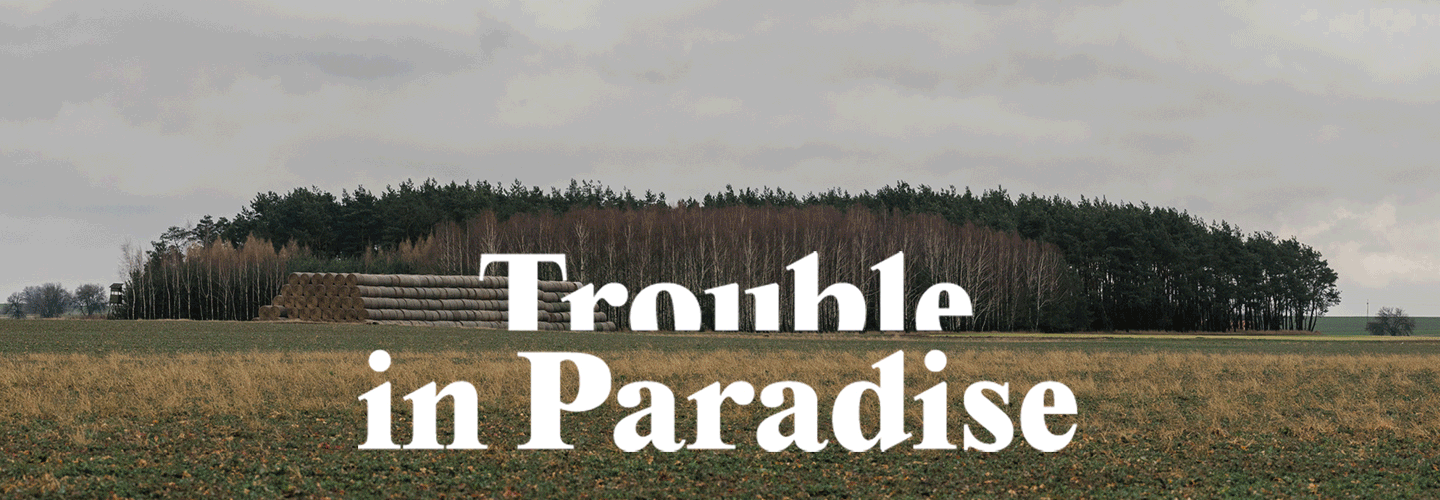Trouble in Paradise
May 22–November 21, 2021
Sestiere Castello
Giardini della Biennale
Venice
Italy
The Architecture Biennale 2021, postponed by a year, opened to the public on May 22. On the inaugural day of the exhibition in the Polish Pavilion, a specially designed digital version of the project launched online, making the project available from anywhere in the world. Experience this digital journey through the Trouble in Paradise exhibition here.
Watch the trailer for the exhibition here.
Although rural areas make up 93% of Poland’s territory, only 40% of the population lives there. This data is an accurate reflection of worldwide trends. Engulfed in spatial chaos, having so far remained on the sidelines of architectural interest, the countryside has become the subject of the exhibition in the Polish Pavilion at the 2021 Architecture Biennale. PROLOG +1, authors of the Trouble in Paradise project, in collaboration with an international ensemble of architects and artists, will show that in times of growing local and global crises, rural areas are key to creating communities.
The Trouble in Paradise exhibition is a multi-threaded story about the future of communal life in the countryside, accompanied by a thorough analysis of the forms of work and life in these areas. The project calls attention to, among other things, the issue of the marginalisation of the countryside; it also points out the problems faced by the inhabitants of the countryside today and shows its enormous, untapped potential.
“The countryside is less and less often a promise of autonomy and escape from the city, and more and more often a storage space, a place for ring roads, production halls, farms, all the infrastructure without which life in large agglomerations would be impossible. This is primarily due to the convictions that the countryside is there to serve, acting as support facilities for the cities. We want to reverse this perspective, to stop thinking of the countryside from a ‘city dweller’ point of view. It’s important to us to show the countryside not as a closed, divided and privatised space, but as a space of ideas—a sense of community influenced by every inhabitant,” says Robert Witczak of the PROLOG +1 curatorial team.
The exhibition consists of an analytical and speculative part. The former, analyses the contemporary Polish countryside from the architectural perspective through the characteristic elements of landscape—products of social, spatial and political processes of the last one hundred years. Panorama of the Polish Countryside is a photorealistic representation depicting the place each of us recognizes, although no one knows where it is—the result of the collaboration between Polish photographers Michał Sierakowski and Paweł Starzec, visual artist Jan Domicz and curators from PROLOG +1. Speculations about the future of the countryside focus on the ways of working and living, where common goods lead to the consolidation of the rural environment. Six Projects for the Countryside are proposed by the European architectural studios invited to participate in the exhibition. Their visions enable us to pose the question of the role the countryside should play today.
Trouble in Paradise offers a different perspective for rural areas, which goes beyond the narrow confines of a romantic or technological utopia. The contemporary countryside is not an innocent, idyllic landscape outside the city, but a space of struggle and resistance.
The exhibition is accompanied by the book Trouble in Paradise, which includes essays by Platon Issaias & Hamed Khosravi, Pier Vittorio Aureli, Andrea Alberto Dutto, Katarzyna Kajdanek, Łukasz Moll, a photo essay by Jacenty Dędek, as well as texts by the PROLOG +1 team, a photographic Panorama of the Polish Countryside and visualisations of the projects. The book will be available for sale in La Biennale’s bookstores, as well as for free download in digital form here.
Curators: PROLOG +1 (Mirabela Jurczenko, Bartosz Kowal, Wojciech Mazan, Bartłomiej Poteralski, Rafał Śliwa and Robert Witczak)
Participants:
–Architectural studios: Atelier Fanelsa, GUBAHÁMORI + Filip + László Demeter, KOSMOS Architects, Rural Office for Architecture, RZUT, Traumnovelle
–Authors of the Panorama of the Polish Countryside: Jan Domicz, Michał Sierakowski, Paweł Starzec, PROLOG +1
–Authors of the Glossary (online): Michał Sierakowski, Paweł Starzec, Wiktoria Wojciechowska, Patrycja Wojtas, PROLOG +1
Organiser: Zachęta — National Gallery of Art, Warsaw
Polish Pavilion Commissioner: Hanna Wróblewska, director of Zachęta — National Gallery of Art
Polish Pavilion Office: Ewa Mielczarek, Joanna Waśko
Polish participation at the 17th International Venice Architecture Biennale was made possible through the financial support of the Ministry of Culture, National Heritage and Sport of the Republic of Poland.
The exhibition in the Polish Pavilion is supported by the Adam Mickiewicz Institute and the Polish Institute in Rome.
Book co-financed by City of Wrocław.
Media contacts:
Joanna Andruszko / Communication Department, Zachęta — National Gallery of Art
j.andruszko [at] zacheta.art.pl / +48 693 974 686
Joanna Waśko / Polish Pavilion Office, Zachęta — National Gallery of Art
j.wasko [at] zacheta.art.pl


